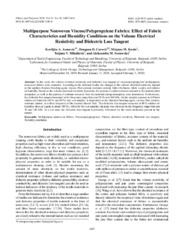Multipurpose Nonwoven Viscose/Polypropylene Fabrics: Effect of Fabric Characteristics and Humidity Conditions on the Volume Electrical Resistivity and Dielectric Loss Tangent
Аутори
Asanović, Koviljka A.
Cerović, Dragana D.
Kostić, Mirjana M.

Mihailović, Tatjana V.

Ivanovska, Aleksandra M.

Чланак у часопису (Објављена верзија)

Метаподаци
Приказ свих података о документуАпстракт
In this work, the volume electrical resistivity and dielectric loss tangent of viscose/polypropylene multipurpose nonwoven fabrics were examined. According to the obtained results, the changes in the volume electrical resistivity depend on the applied chemical bonding agent, viscose fiber content, moisture content, fabric thickness, fabric weight, and relative air humidity. Based on the volume electrical resistivity hysteresis, the portion of sorbed moisture retained in the material after desorption, as well as the portion of moisture removed from the material during desorption, were determined. Furthermore, the dielectric loss tangent measured at the frequency range between 30 Hz and 140 kHz, for the samples exposed to different relative air humidity (40 % and 80 %) and wet samples, is dependent on the chemical bonding agent, viscose fiber content, moisture content, as well as frequency of the external electric field. The dielectric loss tangent measured at 80 % relative air humidity ...showed a peak at about 100 Hz, while for the wet samples, the peak was observed in the frequency range between 30 and 140 kHz. In a wet state, the dielectric loss tangent is primarily influenced by the water molecules present in the sample.
Кључне речи:
Multipurpose nonwoven fabrics / Viscose / polypropylene / Volume electrical resistivity / Dielectric loss tangent / Humidity conditionsИзвор:
Fibers and Polymers, 2020, 21, 10, 2407-2416Издавач:
- Korean Fiber Society
Финансирање / пројекти:
- Министарство науке, технолошког развоја и иновација Републике Србије, институционално финансирање - 200135 (Универзитет у Београду, Технолошко-металуршки факултет) (RS-MESTD-inst-2020-200135)
- Министарство науке, технолошког развоја и иновација Републике Србије, институционално финансирање - 200162 (Универзитет у Београду, Физички факултет) (RS-MESTD-inst-2020-200162)
DOI: 10.1007/s12221-020-1340-4
ISSN: 1229-9197
WoS: 000583056800029
Scopus: 2-s2.0-85094654443
Колекције
Институција/група
Tehnološko-metalurški fakultetTY - JOUR AU - Asanović, Koviljka A. AU - Cerović, Dragana D. AU - Kostić, Mirjana M. AU - Mihailović, Tatjana V. AU - Ivanovska, Aleksandra M. PY - 2020 UR - http://TechnoRep.tmf.bg.ac.rs/handle/123456789/4438 AB - In this work, the volume electrical resistivity and dielectric loss tangent of viscose/polypropylene multipurpose nonwoven fabrics were examined. According to the obtained results, the changes in the volume electrical resistivity depend on the applied chemical bonding agent, viscose fiber content, moisture content, fabric thickness, fabric weight, and relative air humidity. Based on the volume electrical resistivity hysteresis, the portion of sorbed moisture retained in the material after desorption, as well as the portion of moisture removed from the material during desorption, were determined. Furthermore, the dielectric loss tangent measured at the frequency range between 30 Hz and 140 kHz, for the samples exposed to different relative air humidity (40 % and 80 %) and wet samples, is dependent on the chemical bonding agent, viscose fiber content, moisture content, as well as frequency of the external electric field. The dielectric loss tangent measured at 80 % relative air humidity showed a peak at about 100 Hz, while for the wet samples, the peak was observed in the frequency range between 30 and 140 kHz. In a wet state, the dielectric loss tangent is primarily influenced by the water molecules present in the sample. PB - Korean Fiber Society T2 - Fibers and Polymers T1 - Multipurpose Nonwoven Viscose/Polypropylene Fabrics: Effect of Fabric Characteristics and Humidity Conditions on the Volume Electrical Resistivity and Dielectric Loss Tangent EP - 2416 IS - 10 SP - 2407 VL - 21 DO - 10.1007/s12221-020-1340-4 ER -
@article{
author = "Asanović, Koviljka A. and Cerović, Dragana D. and Kostić, Mirjana M. and Mihailović, Tatjana V. and Ivanovska, Aleksandra M.",
year = "2020",
abstract = "In this work, the volume electrical resistivity and dielectric loss tangent of viscose/polypropylene multipurpose nonwoven fabrics were examined. According to the obtained results, the changes in the volume electrical resistivity depend on the applied chemical bonding agent, viscose fiber content, moisture content, fabric thickness, fabric weight, and relative air humidity. Based on the volume electrical resistivity hysteresis, the portion of sorbed moisture retained in the material after desorption, as well as the portion of moisture removed from the material during desorption, were determined. Furthermore, the dielectric loss tangent measured at the frequency range between 30 Hz and 140 kHz, for the samples exposed to different relative air humidity (40 % and 80 %) and wet samples, is dependent on the chemical bonding agent, viscose fiber content, moisture content, as well as frequency of the external electric field. The dielectric loss tangent measured at 80 % relative air humidity showed a peak at about 100 Hz, while for the wet samples, the peak was observed in the frequency range between 30 and 140 kHz. In a wet state, the dielectric loss tangent is primarily influenced by the water molecules present in the sample.",
publisher = "Korean Fiber Society",
journal = "Fibers and Polymers",
title = "Multipurpose Nonwoven Viscose/Polypropylene Fabrics: Effect of Fabric Characteristics and Humidity Conditions on the Volume Electrical Resistivity and Dielectric Loss Tangent",
pages = "2416-2407",
number = "10",
volume = "21",
doi = "10.1007/s12221-020-1340-4"
}
Asanović, K. A., Cerović, D. D., Kostić, M. M., Mihailović, T. V.,& Ivanovska, A. M.. (2020). Multipurpose Nonwoven Viscose/Polypropylene Fabrics: Effect of Fabric Characteristics and Humidity Conditions on the Volume Electrical Resistivity and Dielectric Loss Tangent. in Fibers and Polymers Korean Fiber Society., 21(10), 2407-2416. https://doi.org/10.1007/s12221-020-1340-4
Asanović KA, Cerović DD, Kostić MM, Mihailović TV, Ivanovska AM. Multipurpose Nonwoven Viscose/Polypropylene Fabrics: Effect of Fabric Characteristics and Humidity Conditions on the Volume Electrical Resistivity and Dielectric Loss Tangent. in Fibers and Polymers. 2020;21(10):2407-2416. doi:10.1007/s12221-020-1340-4 .
Asanović, Koviljka A., Cerović, Dragana D., Kostić, Mirjana M., Mihailović, Tatjana V., Ivanovska, Aleksandra M., "Multipurpose Nonwoven Viscose/Polypropylene Fabrics: Effect of Fabric Characteristics and Humidity Conditions on the Volume Electrical Resistivity and Dielectric Loss Tangent" in Fibers and Polymers, 21, no. 10 (2020):2407-2416, https://doi.org/10.1007/s12221-020-1340-4 . .

